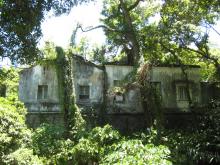70 years ago: Hong Kong's wartime diaries
26 Sep 1945, Barbara Anslow's diary
Submitted by Barbara Anslow on Fri, 2012-06-08 14:59Book / Document:Date(s) of events described:Wed, 26 Sep 1945Anchored Singapore about half past 12. Passed a convoy of small naval craft convoying a large 3-funnelled transport. In harbour were many naval ships, including the aircraft carrier 'Trumpeter' which is a sister ship to us, and the flagship 'Nelson'. We stayed for about 3 hours. We left about 4pm. The little islands around are bristling with trees and bushes sprouting thick and green out of the sea.
Dance on Flight Deck at night. The deck was lit up, the band came up on the lift; 2 very nice singers, and we learned some of the latest (to us) songs. Flags were arrayed on the ropes round the band group. The officers looked very nice, some in black, some in white, and lovely smart cummerbunds. The MC kept saying 'Come along, ladies and gentlemen' because most of the seamen were very bashful.The Captain looked like a film version of a bandit chief, in white silky shirt which billowed in the breeze, black cummerbund and trousers. He made a little speech, said this was probably a unique occasion. Clifton gave a turn which went down very well. ((Clifton and friend Eric MacNider often appeared on Stanley stage together))
26 Sep 1945, Chronology of Events Related to Stanley Civilian Internment Camp
Submitted by brian edgar on Sun, 2013-03-03 21:12Book / Document:Date(s) of events described:Wed, 26 Sep 1945The China Mail (page 2) pays tribute to the Hong Kong resistance. It mentions David Loie, who contacted the BAAG at Waichow 'early' but states that, in general, 'Hong Komg's Heroes of the Fifth Column are nameless'.
The article goes on to claim that most resistance agents were Chinese, but that the Indians were well represented, and that no community of 'third nationals' (neutrals) that was more than half a dozen in size failed to produce at least one operative.
It quotes a Chinese interpreter/clerk who had access to the Gendarmerie files as saying that 2,000 people were executed for resistance activities and that 2,000 more were suspected. However, the real number of those involved, the writer believes, was 'legion'. Some were links in a chain of communication that extended from Gendarmerie HQ to outside Hong Kong, while others provided shelter for fugitives in a network organised by 'an American Chinese whose intelligence, wits and resources would rank with the best in the world'. A Jewish man, with the help of Chinese and Indian warders, managed to get nutritious food smuggled in 'to political prisoners as far as Canton'.
The writer belives that death wasn't the most frequent outcome but nervous breakdown - which might be followed by death from disease or suicide - or flight to Macau. Men would sometimes break down when asked to undertake some task that was beyond the limits of their courage. Traitors were rife in 1942 and 1943 as recruits had to be accepted without proper knowledge of their antecedents. However, the Gendarmerie were often confused by the number of aliases used, and secrecy within cells gave further protection.
The article goes on to list the great variety of tasks undertaken by the resistance. In conclusion, it points to the modesty of the former agents:
To-day (sic) the undergrounders have sunk underground. None will agree to having his name published and they mostly take the attitude that they don't particularly care to have their services to the Allied cause awarded official recognition.
Duncan Sloss, his son John, and Day Sage (Joyce) are among those leaving Hong Kong by plane for Britian.
Les Fisher begins 'spinal treatment' with Dr. Molthen.
Sources:
Sloss, Sage: China Mail, September 28, 1945, 4
Les Fisher, I Will Remember, 1996, 253
Notes:
1) I have not yet been able to identify the American-Chinese organiser of the 'safe house' network. I suspect that the Jewish man who smuggled food to political prisoners in Hong Kong and beyond was Boris Pasco, but I'm far from certain and any further information would be most welcome.
2) Frank Molthen and his wife Ruth introduced chiropractic to Hong Kong in the early 1930s. He is said to have treated both Chiang Kai-shek and Madame Chiang. In Stanley Molthen provided 'adjustments' for both internees and guards.
He was 'guaranteed out' of Stanley in August 1942:
26 Sep 1945, R. E. Jones Wartime diary
Submitted by Admin on Sat, 2015-09-12 17:05Book / Document:Date(s) of events described:Wed, 26 Sep 1945Fine, warm.
More checking up of passengers for Aust. Some had Med. inspection.
Everyone more or less fed up hanging around here. I do almost nothing but think of G.
A/C Smiter called for 1 hour.
26 Sep 1945, INTERNED - DECEMBER 1941
Submitted by Clive Hamilton on Wed, 2017-01-04 15:37Book / Document:Date(s) of events described:Wed, 26 Sep 1945((Following text undated:))
As we were steaming through the China Sea on a glorious night, the Captain asked all the ladies to go down onto the flight deck and dance with the sailors. As I simply adore dancing, I did not need a second invitation, and we danced the whole night through, being thrown from sailor to sailor. They were marvellous dancers as only the sailors who loved dancing turned up.

